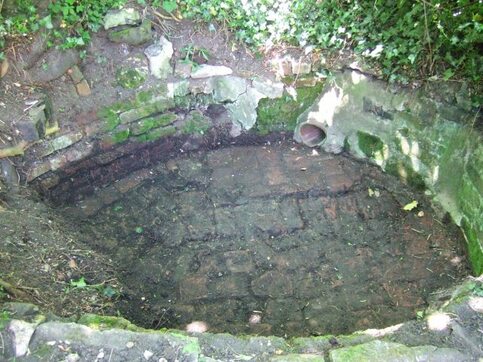The oval pond
|
This is at the back of the garden on the Pound Street side of the rectangular pond. It is shown on the 1868 Ordnance Survey map and was part of the garden of the original Honeywood which was demolished in or about 1884.
The pond is somewhat irregular about 2.4m north to south by 1.7m east to west. The walls are largely of brick and cement. There is some slag or burr-brick decoration on the west side. The east wall has had a Portland cement cap, but this is now much broken. The floor is of peg tile and brick and, on the northwest side, appears to incorporate part of an earlier structure. The peg tile is fixed with brown cement – possibly Parker’s Roman cement. There is a stone block in the southeast corner which may be the lowest of several blocked off steps down into the pond. |
The water came from the pond behind Honeywood through a 6-inch diameter brown salt-glazed stoneware drainpipe. There are two outlet pipes. One, on the north side, leaves through the Portland cement setting for a sluice. It runs through a short rectangular section floored with white ceramic tiles into a 9-inch diameter stoneware drainpipe which is significantly larger than the inflow. This runs into the western end of the culvert under the lawn. The other outlet is a 7-inch diameter red earthenware drainpipe which leaves the east side and probably flowed towards a pond at the southeast corner of the lawn on the site of an existing tree stump. This pond is shown on the 1868 map but was filled in long ago and has never been excavated.
In the next page we look at












